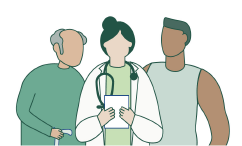Crunching the data to improve Kiwis’ health
15 March 2018
The concept of ‘big data’ is one that conjures up thoughts of conspiracy movies, shadowy agencies monitoring our every move and big-brother-style surveillance. But big data in reality can be a force for good – and the start of better health outcomes for Kiwis, if one large research project proves fruitful.
A heart attack can strike any one of us at any time. Heart disease, also known as cardiovascular disease (CVD), is one of New Zealand’s biggest health burdens (killing more than one in three New Zealanders) and is responsible for more than 30,000 hospital admissions each year.
By using ‘big data’ to create better equations which help identify and predict risk in individuals of heart disease and diabetes, one Healthier Lives research project is working to improve those statistics.
Early detection and better treatment

The key to reducing the health burden of diseases such as CVD and diabetes is early detection and better treatment. The Equitable Cardiovascular and Diabetes risk prediction project aims to improve how well people at risk of heart disease and diabetes are identified, and help turn those people’s health around before the conditions develop. The goal is to improve inequities in the way these conditions are screened, in particular aiming to improve outcomes for Maori and Pacific populations.
Principal Investigator Professor Vicky Cameron at the University of Otago, Christchurch, explains the current issue with screening:
“Currently GPs throughout NZ use some CVD risk scores that were developed in the early 2000s. But they’re based on the general population, so they don’t work particularly well for some of the ethnic groups in NZ, particularly Māori, Pacific or Indian subcontinent peoples. These are the people who suffer the greatest inequities, and yet we’re not very good at identifying who is at risk and therefore intervening early with treatments and recommendations for lifestyle changes in order to reduce that risk, so that they don’t eventually get heart disease”.
Different ethnic groups all have different risk factors that contribute to their potential risk scores. But the current system doesn’t identify these
The power of big data
The project is using very big data indeed to solve this problem. To start with, records from half a million patients are being looked at – data from decision support software known as PREDICT, which is used by doctors to screen and diagnose patients. That includes data from 55,000 Māori, 55,000 Pacific people and 35,000 people of Indian descent. In addition, data has been made available through Statistics NZ’s Integrated Data Infrastructure (IDI). This is administration and government data that has been linked to anonymised individuals’ health records, which have been made available for public good research.
Professor Cameron explains the power of the additional data.
“If you take an individual living in New Zealand, through the IDI, you can get information about whether they are hospitalised, what was the cause, what was the diagnosis. You’ve got mortality data so you can tell if they’ve actually died of heart disease; you can see if they’ve migrated in or out of NZ. You’ve got information from the national pharmaceuticals database so you know what drugs they’ve been treated with which helps identify what other co-morbidities they might have.
“You’ve got the National Laboratory Utilisation database, which shows what blood tests they’ve had, so you can see other co-morbidities or how their body is functioning, and then you’ve got the Primary Health Organisation enrolment database. You can link to their census information so you’ve got information about smoking, education, income level, rurality and whether they live in a high deprivation area”.
Linking anonymised data

Co-principal investigator Professor Rod Jackson and bio statistician Katrina Poppe and their team have been able to link all the data together, to get detailed pictures of individuals’ health. From this, they can build a much more useful picture of different ethnic groups and their relevant risk factors¹.
All the individual patient data is anonymised before the research teams receive it, so that patient privacy is protected.
“It’s done through a third party so it’s linked through the NHI number, then it’s encrypted,” explains Professor Cameron. “Researchers don’t get any information that would identify the individual, they just get the individual profiles of risk. They can get all this information, and keep it confidential, but still look for other risk factors that might be contributing to their risk of heart disease. They’ve done that with each ethnic group separately.”
Better tools for doctors
What this will mean in the near future is that doctors will have better tools to more accurately predict someone’s risk of cardiovascular disease or diabetes. The researchers are in the process of writing different equations for the GP PREDICT software. CVD risk equations will have additional factors which help account for the greater risk in different ethnic groups. These will soon be tested and evaluated in the PREDICT system.
In practice when someone visits their doctor, the change won’t be obvious, but it will make a big difference, says Professor Cameron.
“The doctor puts in information [into the software] that is fairly elementary”, says Professor Cameron, “but behind the scenes, the cogs will turn. It will work out a risk that is specific to that individual. The doctor won’t really be doing much more work than they’re doing now… but now there’s a much more complicated algorithm that the machine is churning through in the background, to estimate the risk”.
That means potentially more patients who are at higher risk will be picked up early and treated more effectively.
“Changing lifestyle factors is important”, says Professor Cameron. “But it’s very hard to make a change there. Changing treatment therapy such as reducing blood pressure, reducing cholesterol, tackling atrial fibrillation, getting diabetes well under control – all of those things can significantly reduce someone’s risk even without major lifestyle changes, so it’s really important that those risk factors get picked up early and managed early, and appropriately for the level of risk”.
This massive ‘data crunch’ is only half of the Equitable Cardiovascular and Diabetes Screening project.
Predicting secondary events
The other half is working with data from people who’ve already had a coronary event (heart attack or angina) and trying to predict who’s likely to have another one.

This study – the Multi-Ethnic NZ Study of Acute Coronary Syndromes (MENZACS)² – is looking at data already collected for the Ministry of Health on coronary patients, including demographic and treatment data. The researchers, led by Professor Cameron and Associate Professor Malcolm Legget at the University of Auckland, are also recruiting participants to provide additional data on lifestyle, diet, physical activity and smoking. They’ll also be taking blood samples with the goal of seeking new and better biomarkers to predict subsequent events, and ultimately also look at genetics and see how this alters people’s risk of secondary events.
Again, this stands to benefit the people who tend to fare worse, healthwise, in New Zealand.
“It’s now been well accepted that in people who have coronary events, the management of their risk factors declines markedly over the 12 months after they’ve been in hospital,” says Professor Cameron.
“They tend to stop taking their medication, or the GPs relax about treating some of their risk factors. But if the risk factors are treated – if the patient is monitored closely and treated effectively – then it really reduces the risk of secondary events.
Optimising treatment
“So [in the future] we can limit the burden to GPs, and patients who have a low-ish risk of secondary events, and really focus on the people who have the highest risk. And as well we may find particular factors which are pertinent to particular ethnic groups…then we’ll be able to target treatments and monitoring more effectively to the people who are most at risk.
The ultimate goal is to reduce inequities in the health system.
Instead of treating everybody the same, and over treating some people, says Professor Cameron, “it’s a matter of trying to really optimise treatments for the people who need it most”.
¹ This part of the work is co-funded by a programme grant from the Health Research Council of New Zealand.
² The MENZACS study is supported by research grants from the Heart Health Research Trust of the Heart Foundation, the Healthier Lives National Science Challenge and University of Auckland.


